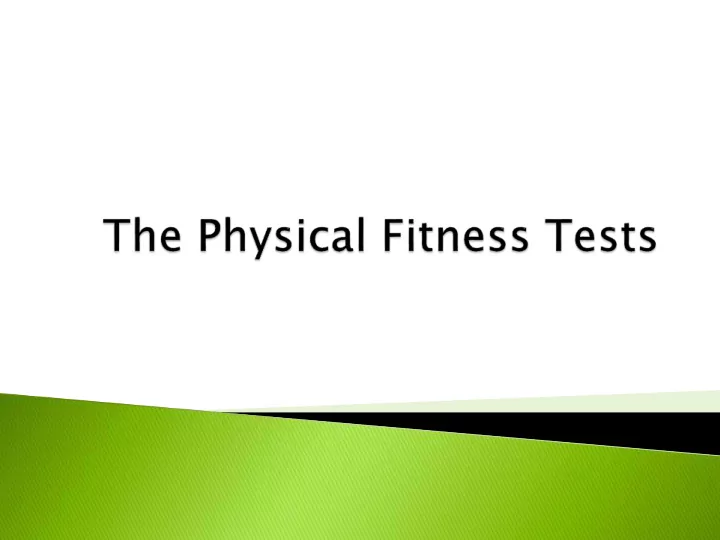

To determine the level of fitness of students. To identify strengths and weaknesses for development/improvement To provide a baseline data for selection of physical activities for enhancement of health and skill performance.
To gather data for the development of norms and standards. To motivate, guide and counsel students in selecting sports for recreation, competition and lifetime participation.
Explain the purpose and benefits that can be derived from the physical fitness tests. Administer the tests at the beginning of the school year and on a quarterly basis, thereafter, to monitor improvement.
Testing paraphernalia: ◦ First Aid Kit ◦ Drinking Water (instruct students to bring their drinking bottles and a small towel or bimpo to wipe their perpiration ) ◦ Individual score cards
Equipment Needed o Tape measure/Meter stick – Body composition, Flexibility, Power, Agility o Weighing/bathroom scale – Body composition o L-square/spirit level – Body composition
Equipment Need o Stop watch - Cardiovascular endurance, Speed, Balance o Step Box/stairs - Cardiovascular endurance o Mat – Muscular strength
Equipment Need o Masking tape/chalk – Agility o Plastic Ruler – Reaction Time o Sipa (washer with straw)/20 pcs. bundled rubber bands/any similar local materials – Coordination
The testing stations should be safe and free from obstructions. The same equipment and testing stations should be used in the start-of-the-year testing and subsequent quarterly testing.
With the guidance of the teachers, allow students to go through the various tests with minimal effort exerted to familiarize themselves with testing procedures. The tests requiring cardio-vascular endurance and those other tests which involve the same muscle groups should not be taken in succession. See suggested sequence of administering the tests.
Student record and keep the result of his own performance in the score card. The school may include the results of the tests in the school’s Enhanced Basic Education Information System (EBEIS)/Learner’s Information System (LIS)/ Educational Management Information System (EMIS).
The students shall be grouped together and in pairs (buddy system). The students should wear appropriate clothing: t-shirt, jogging pants, rubber shoes, or any suitable sports attire. However, when taking the BMI test, it is recommended that the students wear shorts. In all testing for the BMI, the same or similar clothing should be worn by students. Wearing different clothing in all the testing sessions for BMI could affect the results.
Conduct warm-up and stretching exercises before the tests except for the 3-Minute Step Test. Administer the tests in a challenging, encouraging, and fun-filled environment.
Day 1 Day 2 Day 3 BMI Basic Plank Hexagon Agility Test 3 minute step test 40 meter sprint Juggling Push up Standing Long Jump Stick Drop Test Stork Balance Sit and Reach Zipper Test
Body Composition is the body’s relative amount of fat to fat-free mass. Formula: Weight t (kilograms rams) 𝟑 Height ht (meters ers) Classifi ssificat catio ion Below 18.5 Underw erwei eigh ght 18.5 5 – 24.9 Normal 25.0 0 – 29.9 Overwe rweight ight 30.0 0 above Obese se
To test the flexibility of the shoulder girdle
To test the flexibility of the hamstring
- To measure cardiovascular endurance. 3:00 0 min. - do the activity ivity 3:05 5 min - locat ate the pulse se wit ithin hin 5 sec. 3:15 5 - get the pulse se rate 4:00 0 - get the recove very ry HR
To measure strength of the upper extremities
To measure strength/sta bility of the core muscles
To measure running speed
To measure the explosive strength and power of the leg muscles
To measure the ability of the body to move in different directions quickly
To measure the time to respond to a stimulus
To measure the coordination of the eye and hand
To assess one’s ability to maintain equilibrium
Video Presentation of the Tests
Recommend
More recommend